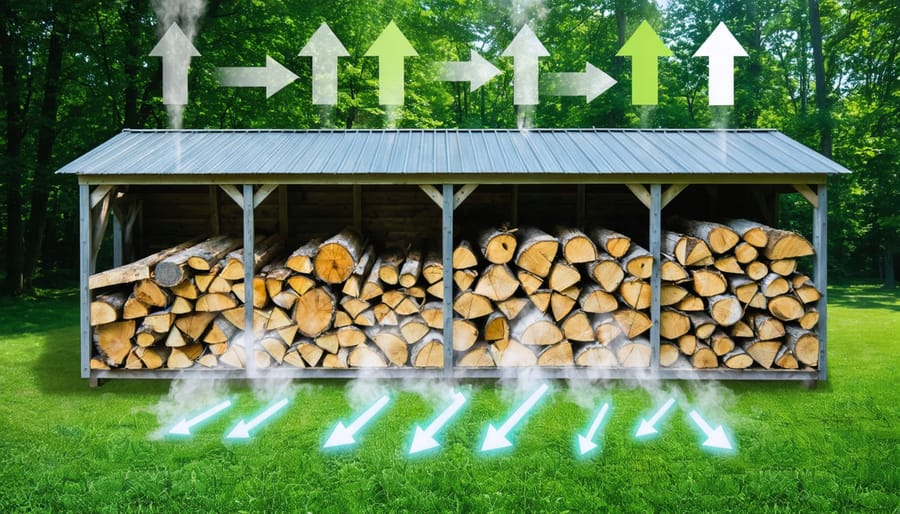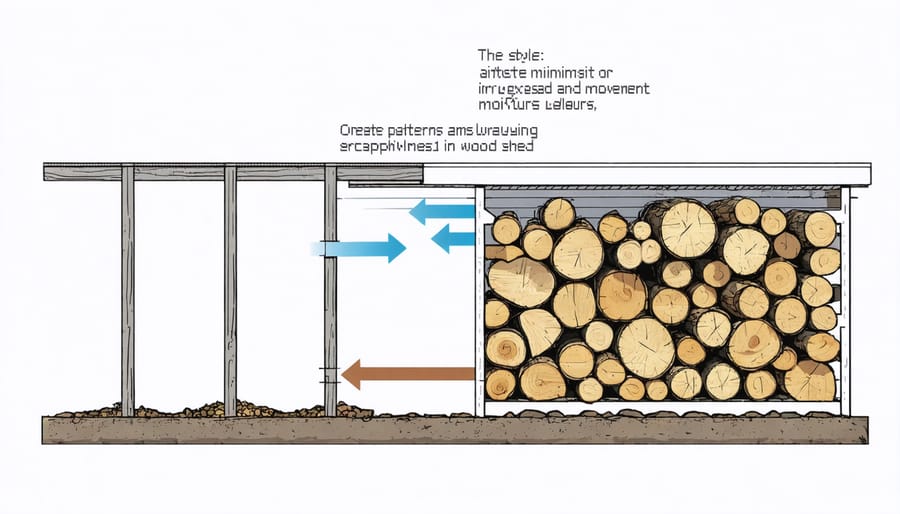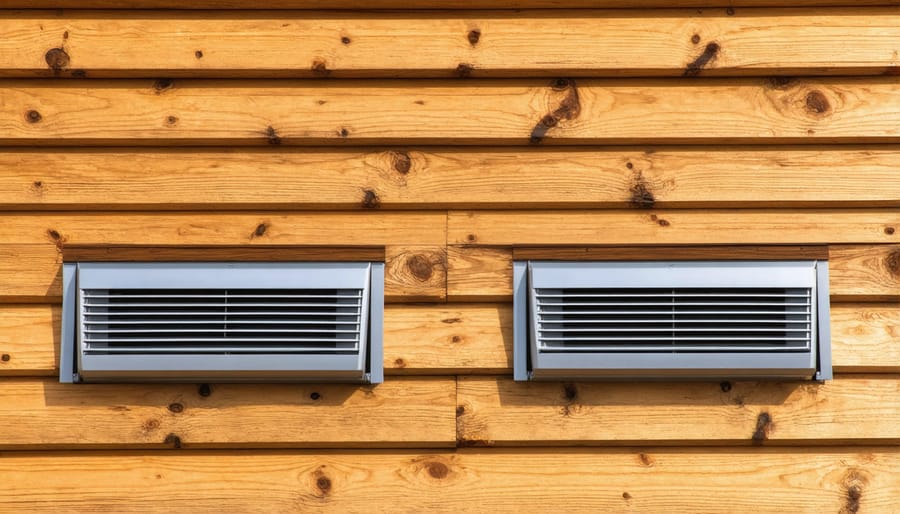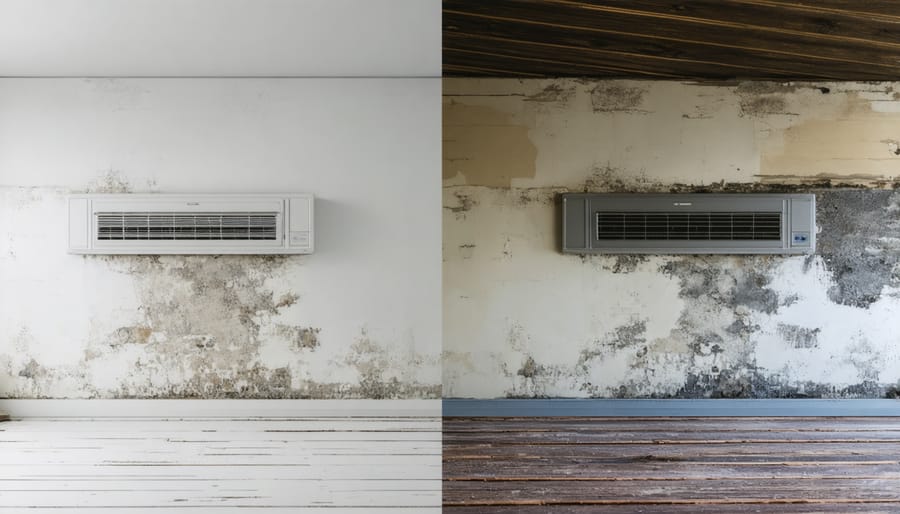Keep Your Wood Shed Dry: Smart Ventilation That Actually Works

Maximize your wood shed’s lifespan and protect valuable firewood by implementing strategic ventilation. Install soffit vents along eaves and ridge vents at the roof peak to create essential airflow that helps prevent moisture damage. Position your wood shed with the prevailing winds in mind, ensuring cross-ventilation through carefully placed gable vents that promote continuous air circulation. Add adjustable foundation vents at ground level to combat rising damp while keeping the wood pile elevated on pallets or pressure-treated supports. Proper ventilation not only extends the life of stored firewood but also protects your shed’s structural integrity, preventing rot and maintaining optimal drying conditions year-round. These proven ventilation strategies work together to create a balanced airflow system that keeps your firewood dry and ready for use while preserving your storage investment.
Why Your Wood Shed Needs Proper Ventilation
Moisture: Your Wood Shed’s Silent Enemy
Moisture is perhaps the biggest threat to both your stored firewood and the structural integrity of your wood shed. When excess moisture accumulates, it creates the perfect breeding ground for mold, mildew, and fungi, leading to serious issues that require extensive wood rot prevention measures. Even properly seasoned firewood can reabsorb moisture from humid air, making it difficult to burn and potentially unusable for heating.
The problem doesn’t stop with your firewood. Moisture trapped within your shed can seep into the walls, floor, and roof, compromising the entire structure over time. In winter, this moisture can freeze and expand, causing warping and cracking. During warmer months, the combination of heat and humidity creates a greenhouse effect, accelerating decay and attracting wood-destroying insects.
The financial impact can be significant – from replacing damaged wood to potentially rebuilding entire sections of your shed. More importantly, damp firewood burns inefficiently and produces more smoke, which can affect both your heating costs and air quality.
The Science of Airflow in Wood Storage
Proper airflow in your wood storage is like a continuous breath of fresh air that keeps your firewood healthy and dry. When air moves freely through your woodshed, it creates a natural circulation pattern that helps prevent moisture from settling and damaging your wood supply.
Think of your woodshed as a breathing structure. Warm, moist air naturally rises, while cooler, drier air stays low. This natural movement helps carry away moisture that would otherwise be trapped around your stored wood. Without adequate ventilation, this moisture can lead to mold growth, wood rot, and ultimately, a less efficient burn when you need that firewood most.
The key to effective airflow lies in creating multiple ventilation points. Air should enter from the bottom of your shed and exit through the top, much like a chimney effect. This continuous movement helps maintain the ideal moisture content in your firewood, typically between 15-20%. Additionally, proper spacing between wood stacks allows air to move horizontally, ensuring even drying throughout your entire wood supply.

Essential Ventilation Features for Your Wood Shed
Ridge Vents and Roof Ventilation
Ridge vents and roof ventilation play a crucial role in maintaining proper airflow through your wood shed. A well-designed ridge vent system creates a natural chimney effect, allowing warm, moist air to escape through the top while drawing in fresh air from below. This continuous air movement helps keep your firewood dry and prevents moisture-related issues.
Installing a ridge vent is relatively straightforward. The most common approach is to leave a 1-2 inch gap along the peak of your shed’s roof, covered by a specialized ridge vent cap. These caps are designed to keep rain and snow out while allowing air to flow freely. For added protection, consider installing a mesh screen underneath to prevent insects and debris from entering.
Many DIY shed builders opt for off-the-shelf ridge vent systems, which typically come with all necessary hardware and installation instructions. When installing, ensure the vent runs the entire length of your shed’s roof for maximum effectiveness. Some homeowners complement ridge vents with soffit vents under the eaves to create a more efficient airflow system.
Pro tip: For areas with heavy snowfall, choose ridge vents with baffles or snow guards to prevent snow infiltration. Additionally, consider installing a slightly wider overhang above the ridge vent to provide extra protection from driving rain while maintaining optimal ventilation.

Wall Vents and Air Gaps
Wall vents and air gaps are essential features that keep your woodshed properly ventilated throughout the year. Installing vents along the walls promotes continuous airflow, which helps maintain dry conditions and prevents wood from becoming damp or moldy.
For optimal ventilation, place vents on opposite walls to create cross-ventilation. A good rule of thumb is to include at least two vents per wall, positioned at different heights to encourage air circulation. Lower vents allow fresh air to enter, while upper vents let warm, moist air escape naturally.
Air gaps between wall boards are another effective ventilation method. When constructing your shed, leave roughly 1/2 inch spacing between boards to allow air movement while still protecting your firewood from rain. These gaps work particularly well with board-and-batten siding, creating natural channels for air to flow.
For enhanced protection, consider installing louvered vents, which can be adjusted based on weather conditions. These are especially useful in areas with heavy rainfall or snow, as they can be partially closed during storms while still maintaining essential airflow.
Remember to keep vents and gaps clear of debris and check them regularly during your seasonal maintenance. Spider webs, leaves, and other blockages can significantly reduce their effectiveness and compromise your wood storage conditions.
Floor Ventilation Solutions
Proper floor ventilation is crucial for keeping your woodshed dry and your firewood in optimal condition. The key is to create a barrier between your wood and the ground while ensuring adequate airflow from beneath. A well-designed floor system acts as your first line of defense against ground moisture and helps prevent wood rot.
Start by elevating your woodshed floor at least 6 inches off the ground. You can achieve this using concrete blocks, pressure-treated lumber, or gravel base with floor joists. For the most effective ground-level ventilation, consider installing a slatted floor with small gaps between boards. These gaps allow air to circulate freely while preventing smaller pieces of wood from falling through.
A popular and effective approach is to create a raised platform using pallets. Pallets naturally provide excellent airflow and keep wood elevated. If using pallets, ensure they’re in good condition and treated for outdoor use. For added protection, lay down a permeable weed barrier beneath your shed’s floor structure while maintaining gaps for ventilation.
Another smart solution is installing adjustable foundation vents around the shed’s base. These can be opened during dry weather and closed during heavy rain, giving you control over ground-level airflow. Remember to keep the area around your shed clear of vegetation and debris that could block these lower ventilation points.
For best results, combine floor ventilation with proper drainage around your shed. A slight slope away from the structure and a layer of gravel will help prevent water from pooling beneath your woodshed.
Simple DIY Ventilation Improvements
Quick Fixes for Better Airflow
Need to improve your wood shed’s airflow right away? Here are several quick and effective solutions you can implement today. Start by clearing any debris or vegetation that might be blocking air movement around your shed’s foundation and walls. Even a few inches of clearance can make a significant difference in air circulation.
Create instant ventilation by installing battery-operated fans in strategic locations. Place one fan near the floor to draw in fresh air and another near the ceiling to expel warm, moist air. This creates a natural circulation pattern that helps keep your firewood dry.
For a no-cost solution, simply leave your shed door open on dry, breezy days. This allows fresh air to circulate through your stored wood and helps prevent moisture buildup. If security is a concern, consider installing a screen door that can remain closed while still allowing airflow.
Another quick fix is to drill several 1-inch holes along the upper and lower portions of your shed walls. Space them about 2 feet apart and cover them with mesh screens to keep out insects and small animals while maintaining good airflow.
You can also add temporary vents by cutting small openings in the eaves and installing inexpensive plastic vents from your local hardware store. These can be installed in under an hour with basic tools and provide immediate improvement to your shed’s ventilation.
For added moisture control, place a few bags of moisture-absorbing crystals throughout your shed. While not a permanent solution, these can help manage humidity levels while you work on more permanent ventilation improvements.
Seasonal Ventilation Adjustments
Proper ventilation needs change throughout the year, and making seasonal adjustments to your wood shed’s airflow is crucial for protecting your firewood investment. Following these seasonal maintenance tips will help ensure your wood stays in prime condition regardless of weather conditions.
During summer months, maximize ventilation to prevent moisture buildup and encourage proper drying. Keep all vents fully open and remove any temporary winter covers. Consider installing additional temporary screening on larger openings to keep insects out while maintaining optimal airflow.
As autumn approaches, begin monitoring humidity levels more closely. While maintaining good airflow is still important, you’ll want to start preparing for wet weather. Check that roof vents are clear of fallen leaves and debris that could restrict air movement.
Winter requires a balanced approach. While you need to protect stored wood from snow and rain, don’t completely seal off the shed. Use adjustable vent covers to reduce—but not eliminate—airflow during severe weather. Position these covers to deflect wind-driven precipitation while still allowing some air movement.
In spring, gradually increase ventilation as temperatures rise. This is particularly important as stored wood begins to warm up, which can create condensation if air movement is insufficient. Remove winter vent covers progressively rather than all at once to prevent sudden temperature changes that could affect wood quality.
Remember to check weather forecasts regularly and adjust ventilation accordingly. Quick responses to changing conditions will help maintain the perfect balance between protection and airflow throughout the year.
Monitoring and Maintenance Tips
Signs of Poor Ventilation
Recognizing poor ventilation early can save you from costly wood damage and maintenance headaches. Watch for condensation or water droplets forming on the interior walls or ceiling of your shed, especially during temperature changes. A musty or damp smell is another clear indicator that moisture isn’t escaping properly. If you notice your stored wood feeling damp to the touch or developing dark spots, this suggests inadequate air circulation.
Pay attention to any visible mold growth on walls, wood, or other surfaces, as this is a definitive sign of excessive moisture. Your wood may also feel softer than usual or show signs of warping. During winter months, frost accumulation on the inside of your shed’s roof indicates poor ventilation is trapping warm, moist air.
Keep an eye on door hinges and metal tools stored in your shed – if they’re developing rust more quickly than usual, your ventilation might need improvement. Additionally, if spiders and other moisture-loving insects are making themselves at home in greater numbers, this could signal ventilation issues that need addressing.

Regular Maintenance Checklist
Keep your wood shed’s ventilation system in top condition with this easy-to-follow maintenance checklist, which should be part of your regular shed maintenance routine:
1. Monthly Inspection
– Check all vents for debris, cobwebs, or pest nests
– Ensure vent flaps move freely and aren’t stuck
– Look for signs of rust or deterioration around vent frames
– Verify that screening material is intact
2. Seasonal Tasks (Spring and Fall)
– Clean all vent openings thoroughly with a brush
– Test mechanical vents for smooth operation
– Lubricate moving parts if necessary
– Clear vegetation growing near ground-level vents
3. Annual Maintenance
– Replace damaged screens or vent covers
– Check seals around vent installations
– Tighten any loose fasteners
– Apply rust prevention treatment if needed
4. After Severe Weather
– Inspect for storm damage
– Clear any debris blocking airflow
– Check for water infiltration
– Ensure ridge vents remain properly sealed
Remember to document any issues you find and address them promptly to maintain optimal airflow and protect your stored wood from moisture damage.
Proper ventilation in your wood shed is not just a helpful feature – it’s essential for protecting your investment and ensuring your firewood stays in prime condition. By implementing the ventilation strategies we’ve discussed, including strategic air gaps, roof vents, and proper spacing between wood stacks, you’ll create an environment that prevents moisture buildup and promotes natural airflow. Remember that good ventilation works hand-in-hand with proper shed placement and regular maintenance to keep your firewood dry and ready for use. Taking the time to plan and install adequate ventilation now will save you countless headaches and extend the life of both your wood shed and its contents. Don’t wait for moisture problems to develop – start implementing these ventilation solutions today to ensure your wood shed serves you well for years to come.

